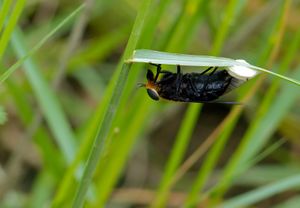ذبابة الخيل
| ذبابة الخيل | |
|---|---|
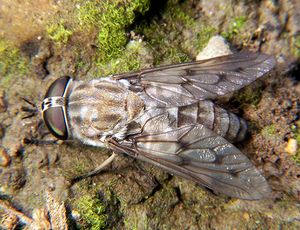
| |
| Hybomitra micans | |
| التصنيف العلمي | |
| مملكة: | |
| Phylum: | |
| Class: | |
| Order: | |
| Suborder: | |
| Infraorder: | |
| Superfamily: | |
| Family: | Tabanidae |
| Subfamilies | |
|
See text | |
ذبابة الخيل Horse-flies هي are true flies in the family Tabanidae in the insect order Diptera. They are often large and agile in flight, and the females bite animals, including humans, to obtain blood. They prefer to fly in sunlight, avoiding dark and shady areas, and are inactive at night. They are found all over the world except for some islands and the polar regions.
Adult horse flies feed on nectar and plant exudates; the males have weak mouthparts and only the females bite animals to obtain enough protein from blood to produce eggs. The mouthparts of females are formed into a stout stabbing organ with two pairs of sharp cutting blades, and a spongelike part used to lap up the blood that flows from the wound. The larvae are predaceous and grow in semiaquatic habitats.
Female horseflies can transfer blood-borne diseases from one animal to another through their feeding habit. In areas where diseases occur, they have been known to carry equine infectious anaemia virus, some trypanosomes, the filarial worm Loa loa, anthrax among cattle and sheep, and tularemia. As well as making life outdoors uncomfortable for humans, they can reduce growth rates in cattle and lower the milk output of cows if suitable shelters are not provided.
Horse-flies have appeared in literature since Aeschylus in Ancient Greece mentioned them driving people to madness through their persistent pursuit. Shakespeare uses the theme of the maddening gadfly in his plays King Lear and Antony and Cleopatra.
. . . . . . . . . . . . . . . . . . . . . . . . . . . . . . . . . . . . . . . . . . . . . . . . . . . . . . . . . . . . . . . . . . . . . . . . . . . . . . . . . . . . . . . . . . . . . . . . . . . . . . . . . . . . . . . . . . . . . . . . . . . . . . . . . . . . . . . . . . . . . . . . . . . . . . . . . . . . . . . . . . . . . . . .
الوصف
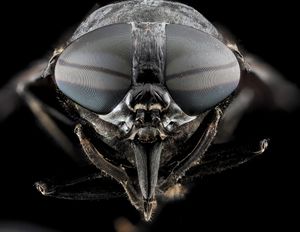
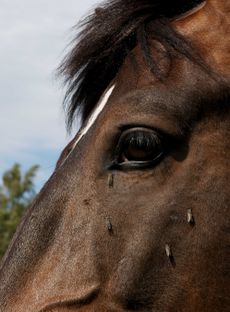
الانتشار والموئل
Horse-flies are found worldwide, except for the polar regions, but they are absent from some islands such as Greenland, Iceland, and Hawaii.[2] The genera Tabanus, Chrysops, and Haematopota all occur in temperate, subtropical and tropical locations, but Haematopota are absent from Australia and South America.[3] Horse-flies mostly occur in warm areas with suitable moist locations for breeding, but also occupy a wide range of habitats from deserts to Alpine meadows. They are found from sea level to at least 3,300 metres (10,800 ft).[4]
التطور والتبويب
The first record of a tabanid comes from the Late Jurassic of China, and specimens from the Cretaceous have been found in England, Spain, and possibly South Africa. In the New World, the first discoveries date from the Miocene of Florissant, Colorado. These insects are recognisable as tabanids both from their mouthparts and their wing venation.[5] Although the bloodsucking habit is associated with a long proboscis, a fossil insect that has elongated mouthparts is not necessarily a bloodsucker, as it may instead have fed on nectar.[6] The ancestral tabanids may have co-evolved with the angiosperm plants on which they fed.[7] With a necessity for high-protein food for egg production, the diet of early Tabanomorphs was probably predatory, and from this the bloodsucking habit may have evolved. In the Santana Formation in Brazil, no mammals have been found, so the fossil tabanids found there likely fed on reptiles. Cold bloodsucking probably preceded warm bloodsucking, but some dinosaurs are postulated to have been warm-blooded and may have been early hosts for the horse-flies.[5]
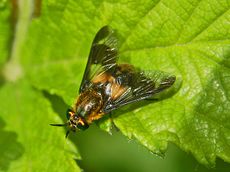
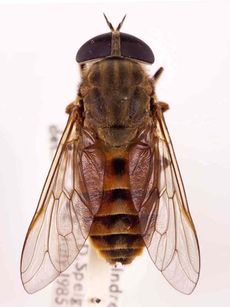
- Subfamily Chrysopsinae (deer flies or banded horse-flies)
- Subfamily Pangoniinae (long-tongued horse-flies)
- Subfamily Tabaninae (horse-flies)
علم الأحياء
سلوك الطعام والعض
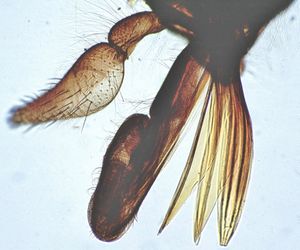
المفترسون والطفيليات
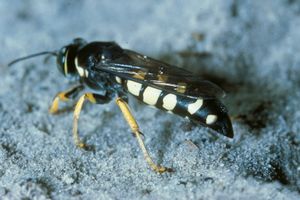
التكاثر
كناقل للأمراض
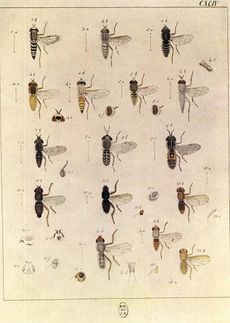
عضة ذبابة الخيل
Humans find horse-fly bites painful. There is usually a weal (raised area of skin) around the site and other symptoms may include urticaria (a rash), dizziness, weakness, wheezing, and angioedema (a temporary itchy, pink or red swelling occurring around the eyes or lips); a few people experience an allergic reaction.[8] The site of the bite should be washed and a cold compress applied. Scratching the wound should be avoided and an antihistamine preparation can be applied. In most cases, the symptoms subside within a few hours but if the wound becomes infected, medical advice should be sought.[9]
في الأدب
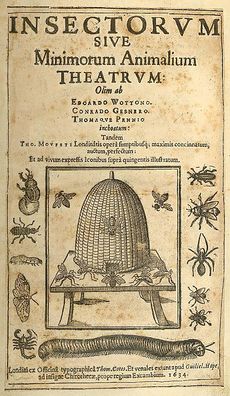
. . . . . . . . . . . . . . . . . . . . . . . . . . . . . . . . . . . . . . . . . . . . . . . . . . . . . . . . . . . . . . . . . . . . . . . . . . . . . . . . . . . . . . . . . . . . . . . . . . . . . . . . . . . . . . . . . . . . . . . . . . . . . . . . . . . . . . . . . . . . . . . . . . . . . . . . . . . . . . . . . . . . . . . .
انظر أيضاً
الهامش
- ^ International Commission on Zoological Nomenclature (1961). The Bulletin of Zoological Nomenclature. International Trust for Zoological Nomenclature. p. 55.
- ^ خطأ استشهاد: وسم
<ref>غير صحيح؛ لا نص تم توفيره للمراجع المسماةIFAS - ^ خطأ استشهاد: وسم
<ref>غير صحيح؛ لا نص تم توفيره للمراجع المسماةCook - ^ Middlekauff, Woodrow Wilson; Lane, Robert S. (1980). Adult and Immature Tabanidae (Diptera) of California. University of California Press. pp. 1–2. ISBN 978-0-520-09604-2.
- ^ أ ب Martins-Neto, Rafael Gioia (2003). "The fossil tabanids (Diptera Tabanidae): When they began to appreciate warm blood and when they began to transmit diseases?" (PDF). Mem Inst Oswaldo Krubs. 98 (1): 29–34. doi:10.1590/s0074-02762003000900006. PMID 12687759.
- ^ Grimaldi, David; Engel, Michael S. (2005). Evolution of the Insects. Cambridge University Press. pp. 522–. ISBN 978-1-107-26877-7.
- ^ خطأ استشهاد: وسم
<ref>غير صحيح؛ لا نص تم توفيره للمراجع المسماةMorita - ^ "Symptoms of insect bites and stings". NHS Choices. 27 June 2014. Retrieved 30 September 2015.
- ^ "Treating insect bites and stings". NHS Choices. 27 June 2014. Retrieved 30 September 2015.
وصلات خارجية
 Information related to Tabanidae from Wikispecies.
Information related to Tabanidae from Wikispecies.
 Media related to Tabanidae at Wikimedia Commons
Media related to Tabanidae at Wikimedia Commons
